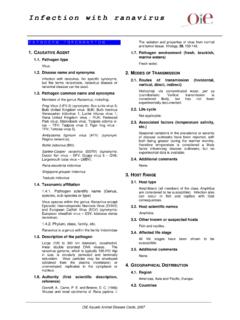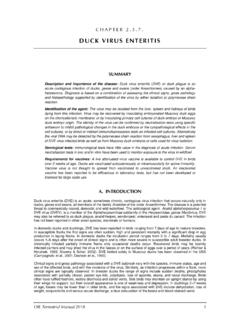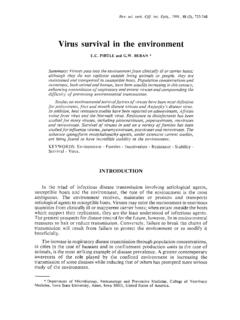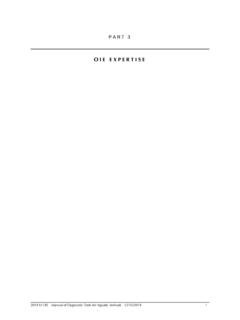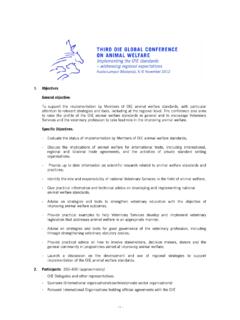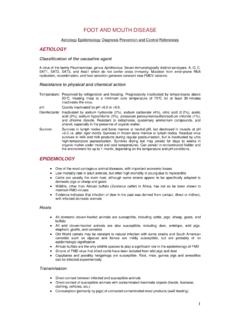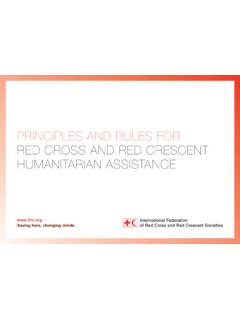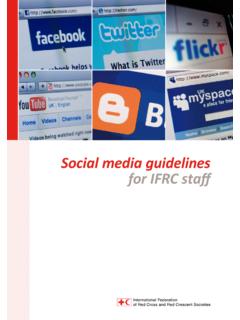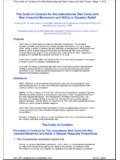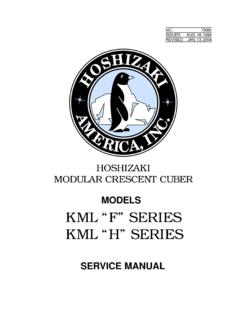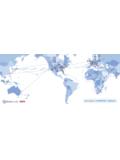Transcription of RED SEA BREAM IRIDOVIRAL DISEASE - Home: OIE
1 Manual of Diagnostic Tests for Aquatic Animals 2009 251 CHAPTER RED SEA BREAM IRIDOVIRAL DISEASE 1. Scope For the purpose of this chapter, red sea BREAM IRIDOVIRAL DISEASE (RSIVD) (8) is caused by infection with red sea BREAM iridovirus. RSIVD is a significant cause of mortality in farmed red sea BREAM (Pagrus major) and more than 30 other species of cultured marine fish (15, 21) belonging mainly to the orders Perciformes and Pleuronectiformes. The first outbreak of RSIVD was recorded in cultured red sea BREAM in Shikoku Island, Japan in 1990 (8).
2 Since then, the DISEASE has caused mass mortalities in cultured fish populations in the western part of Japan, mainly among juvenile red sea BREAM . Affected fish become lethargic, exhibit severe anaemia, petechiae of the gills, and enlargement of the spleen (8, 12, 24). The DISEASE is characterised by the appearance of enlarged cells stained deeply with Giemsa solution in the histopathological observations of the spleen, heart, kidney, intestine and gill of infected fish (8). Recently, it has been proved that the DISEASE is caused not only by RSIV (8 10, 18, 20, 29) and its synonyms (2 6, 12, 13, 16, 19, 22, 40), but also by infectious spleen and kidney necrosis virus (ISKNV) (7, 31).
3 The DISEASE is found not only in Japan but also widely in East and South-East Asian countries (2 6, 9, 10, 12, 13, 16, 19, 22, 31, 40). A monoclonal antibody (MAb) against RSIV (30) can detect both RSIV and ISKNV, whereas it does not recognise fish ranaviruses (family: Iridoviridae) by immunofluorescent antibody tests (IFAT) (28, 31). A number of useful diagnostic methods are in use, such as the observation of stained impression smears or tissue sections, an IFAT using an MAb, and polymerase chain reactions (PCR) (11, 17, 25, 28, 32, 33).
4 A formalin-killed vaccine for RSIVD is effective and is commercially available in Japan (26, 27). 2. DISEASE information Agent factors Aetiological agent, agent strains The DISEASE is caused by red sea BREAM iridovirus (RSIV) (8 10, 18, 20, 29) Ehime-1 strain and other genotypes of RSIV, including many viruses that are considered to be synonyms of RSIV (2 6, 12, 13, 16, 22, 40). The DISEASE is also caused by infectious spleen and kidney necrosis virus (ISKNV) (7, 31), which is one of the viruses related to, but distinct from, RSIV.
5 A number of other iridoviruses that cause similar diseases in ornamental freshwater fish have been reported (34, 39). These viruses are difficult to distinguish genetically from ISKNV, and it has not been determined whether these diseases should be included in RSIVD. Recently, turbot reddish body iridovirus (TRBIV) (37) and its probable synonyms (4, 10), which are related to, but distinct from, RSIV and ISKNV, were reported from the People s Republic of China and the Republic of Korea.
6 Further investigation is necessary before it can be determined whether or not the DISEASE caused by TRBIV should also be included in RSIVD. All these agents belong to the fifth genus of the family Iridoviridae, and they are distinguishable genetically and biologically from fish ranaviruses such as epizootic haematopoietic necrosis virus (EHNV), European catfish iridovirus (ECV) and grouper iridovirus (GIV= Singapore grouper iridovirus [SGIV]) (14, 23, 35 38), none of which is pathogenic to the red sea BREAM (24).
7 Survival outside the host Unknown. Stability of the agent (effective inactivation methods) Inactivated at 56 C for 30 minutes; sensitive to ether and chloroform; inactivated by formalin ( ); stable in tissue at 80 C. Life cycle Not applicable. Chapter Red sea BREAM IRIDOVIRAL DISEASE 252 Manual of Diagnostic Tests for Aquatic Animals 2009 Host factors Susceptible host species In the case of RSIV infection: red sea BREAM (Pagrus major), black porgy (Acanthopagrus schlegeli), yellowfin sea BREAM (Acanthopagrus latus), crimson sea BREAM (Evynnis japonica), Japanese amberjack (Seriola quinqueradiata), greater amberjack (Seriola dumerili), yellowtail amberjack (Seriola lalandi), hybrid of yellowtail amberjack and Japanese amberjack (S.)
8 Lalandi S. quinqueradiata), striped jack (Pseudocaranx dentex), northern bluefin tuna (Thunnus thynnus), Japanese Spanish mackerel (Scomberomorus niphonius), chub mackerel (Scomber japonicus), Japanese jack mackerel (Trachurus japonicus), Japanese parrotfish (Oplegnathus fasciatus), spotted knifejaw (Oplegnathus punctatus), cobia (Rachycentron canadum), snubnose pompano (Trachinotus blochii), chicken grunt (Parapristipoma trilineatum), crescent sweetlips (Plectorhinchus cinctus), Chinese emperor (Lethrinus haematopterus), spangled emperor (Lethrinus nebulosus), largescale blackfish (Girella punctata), rockfish (Sebastes schlegeli), croceine croaker (Pseudosciaena crocea), Hong Kong grouper (Epinephelus akaara), convict grouper (Epinephelus septemfasciatus), Malabar grouper (Epinephelus malabaricus), longtooth grouper (Epinephelus bruneus), orange-spotted grouper (Epinephelus coioides), yellow grouper (Epinephelus awoara)
9 , greasy grouper (Epinephelus tauvina), brown-marbled grouper (Epinephelus fuscoguttatus), giant grouper (Epinephelus lanceolatus), Japanese sea perch (Lateolabrax japonicas), Lateolabrax sp., barramundi or sea bass (Lates calcarifer), hybrid of striped sea bass and white bass (Morone saxatilis M. chrysops), largemouth bass (Micropterus salmoides), bastard halibut (Paralichthys olivaceus), spotted halibut (Verasper variegatus), and torafugu (Takifugu rubripes), are known to be susceptible. In the case of ISKNV infection: Chinese perch (Siniperca chuatsi), red drum (Sciaenops ocellatus), flathead mullet (Mugil cephalus), and Epinephelus sp.
10 Are known to be susceptible. Susceptible stages of the host Juvenile to adult (the susceptibility of juveniles is generally higher than adults). Species or subpopulation predilection (probability of detection) In the case of RSIV infection, fish belonging to the genus Oplegnathus are more sensitive than others. Target organs and infected tissue Infected cells are observed in the spleen, kidney, heart, intestine and gill. Persistent infection with lifelong carriers Unknown. Vectors Unknown. Known or suspected wild aquatic animal carriers Unknown.

